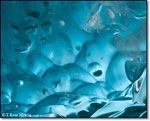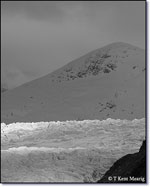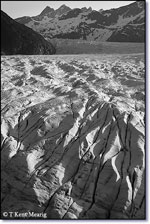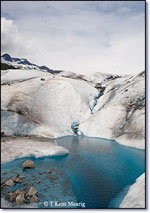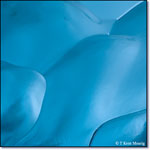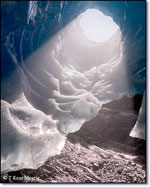 |
 |
||||
It's not known on the scale of the Grand Canyon or Denali but, for many years, I've considered the Mendenhall Glacier to be a photographic icon. I'm not sure what qualifies a subject as an icon - and the term is quite subjective in nature - still, when you've seen so many uninspired and dry photographs of a landmark up for sale in various shops, you come to some conclusions. When people line up with the latest digital cameras to to snap a few shots under the midday sun (or pouring rain) before hopping back on the bus, this glacier has apparently reached some level of picture-requiring status. Does that mean we should add the Mendenhall to the list of photographic clichés tha us "real" photographers must avoid at all costs? On the contrary - I believe the creative possibilities inspired by this "icon" have been excitingly overlooked. Juneau, the capital city of Alaska, is located at the heart of the Tongass National Forest, tucked neatly between the waterways of the Inside Passage and the glaciers of the Juneau Icefield. Many of the thousands of visitors Juneau enjoys each day of the summer season are planning their trip to the Mighty Mendenhall. Most of these will end up wandering the paths around the visitor center, gazing at the fantastic mass of ice on the far side of Mendenhall Lake. Every year millions of photos are made from this location but, in my opinion, it takes unique atmosphere and light to create a photo that can truly relate the scene's grandeur. My strongest images from the east side of the lake involved a unique mix of low clouds and bright sun (or else they were made at night). Since the low clouds of Southeast Alaska rarely share their stage with sun of any kind, it's generally unusual for the Mendenhall Glacier visitor center to be a photographically satisfying destination. A short drive to the west side of the lake brings us to a multi-purpose trailhead, if ever there were one. Would you like to summit a 4,000ft peak, take a peaceful walk through a spruce forest, ice climb in a moulin, explore subglacial caves, or just soak in one of the most breathtaking grand vistas a photographer could ever hope to see? Just follow that trail and start praying that you make the right turn, or you could end up a long way from your expectations. There are multiple tour companies that offer guided trips on the West Glacier Trail as an inexpensive alternative to helicopter flights ending in dogsled rides. On sunny summer days I get the impression that some visitors are starting up the trail just hoping they'll run into me or someone else who knows where they're going, and I'm usually happy to play tour guide. The West Glacier trail ends where a left turn would point you in the direction of the peak of Mt. McGinnis. Just a few thousand feet away, in a predominantly upward direction, it's a playground for mountain goats and their human counterparts. At the point you choose not to turn, maneuvering over an outcropping of rock will position you on the edge of a landscape of immense proportions. The glacier, over a mile wide and several miles long, flows by just below your feet like a giant river of light and shadow. In the distance, the Mendenhall Towers, jagged sky-scraping ridges that soar to over 6,000ft, dominate the scenery along with the rest of the surrounding mountains cloaked in the dense green forest. My favorite time to photograph this location is early on a summer morning, when the sun is just high enough to light up the rough texture of the glacier's surface. Considering the rough look of the glacier translates to steep spires and deep crevasses when you step on it, I typically think of the top of the Mendenhall as more of a place for having fun rather than setting up your expensive camera equipment. The danger is actually quite negligible when you travel on the glacier with an experienced guide, or if you have such experience yourself. In most seasons, crampons and an ice axe are a must, but they are sufficient to make most endeavors comfortable instead of terrifying. My creative sense needs to be in peak condition to bring back an engaging image from the top of the glacier, though I imagine it might be a commercial-stock or adventure-sports photographer's dream on a sunny day. The real treat of the Mendenhall glacier is that it is physically accessible, as opposed to being simply visible. If you're willing to put in a little effort you can walk on it, or under it; you can touch it or, if you want, you can even lick it. If your goal is to generate a remarkable photograph of a subject, you should start by immersing yourself in it, which is why I so often choose the caves as my destination. Once you take a few steps inside, it's like a whole different world - a place that most people will never be lucky enough to see. It reminds me of the slot canyons of the southwest in that, until you've experienced it yourself, you can't even begin to understand what it's like. The colors, shapes, textures, and sounds are unique to just a handful of places on earth, so I pray that my photographs will do the icy formations justice before they're gone. Whether global warming is our fault or not, the most accessible cave on the Mendenhall glacier is on track towards becoming a piece of history in the not-too-distant future. Each year the ice on the west edge of the glacier retreats by fifty to a hundred feet, according to my rough estimations, and the face is known to retreat by well over a hundred feet per year. It's in the nature of ice to be constantly changing, and even if the glacier were advancing, the magical shapes of the Mendenhall's caves would be different with each new day, so I'll still be sorry when this cave is gone. My experiences underneath the ceiling of thick ice have brought me joy, insight, inspiration, and a connection with things bigger than me or the Mendenhall. As humans, we have a tendency to want things for ourselves, and I've fallen into the trap of thinking it would be nice if I could keep the locations around the Mendenhall Glacier to myself. Fortunately, though, they were created for the enjoyment of any person whose path they cross, and I think it would benefit a great many people to let their paths lead this way. Glaciers in Juneau and around the world hold more than we will be able to appreciate or understand in a hundred lifetimes. So, I encourage anyone who has the desire to come and take a piece of what this glacier has to offer, whether it's on your list of icons or not. KM-NPN 2751 Comments on NPN landscape photography articles? Send them to the editor. Kent Mearig resides in Alaska with his wife Breea, and he specializes in photographing his hometown of Juneau. To see more of his photographs and writing, you can visit tkmphoto.com. | |||||
|
|
|||||
